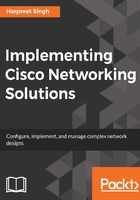
Prepare phase
It is said with reference to the OSI layers that there is an eighth layer that rides preceding the application layer, and that is the business layer, as this is the layer that will define what applications are to be used on the network. The prepare phase tries to capture the business layer and the technological requirements of the underlying network infrastructure.
The prepare and the plan phases of the network lifecycle talk about the future and then hand it over to the next phases, which are concerned with how to build the present network so that it can meet the future requirements.
The prepare phase involves establishing the organizational requirements from a business perspective, and developing an appropriate technology strategy. The following are some examples of questions to be answered in this stage:
- What is the vision of the company?
- What are the business goals of the company today, and anticipating the goals and IT requirements in the future?
- What is the cloud strategy for the organization?
- Would the organization want to own the network assets and build a data center, or just host the applications in an outsourced data center?
- What will be the model of the DC outsourcing? Infrastructure as a Service or Platform, or Software as a Service?
- What is the communications strategy of the company? Would the company want to move to cloud-based models for its internal communications?
- What will be the WAN strategy for the network? Would the WAN links be owned or on a shared network?
- What is the Operations strategy for the organization?
The end goal of this stage is to develop a network strategy by comparing the different options and to propose an architectural view that identifies the various technologies to be used in the network, and the interdependencies between the various technologies. This phase also covers a lot of financial analysis, and building business cases for the decisions as all decisions have to be backed by sound financial reasoning.
By preparing for the network rollout in this manner, the company has a fair view of the budgetary requirements for the project in terms of time, money, and resources, and a long-term roadmap that can be leveraged as the business requirements change with time.
Most of these decisions are taken by the senior management and have already been taken by the time a network is being designed and implemented. Hence, we will not delve any further into these aspects in this book, but focus on the implications of the various technologies and how they impact the operational and business models in subsequent chapters.